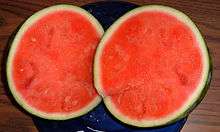Seedless fruit
A seedless fruit is a fruit developed to possess no mature seeds. As consumption of seedless fruits is generally easier and more convenient, they are considered commercially valuable.

Most commercially produced seedless fruits have been developed from plants whose fruits normally contain numerous relatively large hard seeds distributed throughout the flesh of the fruit.[1][2][3][4]
Varieties
Common varieties of seedless fruits include watermelons, tomatoes,[4] grapes (such as Termarina rossa[5]), and bananas. Additionally, there are numerous seedless citrus fruits, such as oranges, lemons and limes.
The term "seedless fruit" is biologically somewhat contradictory, since fruits are usually defined botanically as mature ovaries containing seeds.
Seedless fruits can develop in one of two ways: either the fruit develops without fertilization (parthenocarpy), or pollination triggers fruit development, but the ovules or embryos abort without producing mature seeds (stenospermocarpy). Seedless banana and watermelon fruits are produced on triploid plants, whose three sets of chromosomes make it very unlikely for meiosis to successfully produce spores and gametophytes. This is because one of the three copies of each chromosome can't pair with another appropriate chromosome before separating into daughter cells, so these extra third copies end up randomly distributed between the two daughter cells from meiosis 1, resulting in the (usually) swiftly lethal aneuploidy condition. Such plants can arise by spontaneous mutation or by hybridization between diploid and tetraploid individuals of the same or different species. Some species, such as tomato,[4] pineapple, and cucumber, produce fruit in which there is no seed to be found if not pollinated but will produce seeded fruit if pollination occurs.
Lacking seeds, and thus the capacity to propagate via the fruit, the plants are generally propagated vegetatively from cuttings, by grafting, or in the case of bananas, from "pups" (offsets). In such cases, the resulting plants are genetically identical clones. By contrast, seedless watermelons are grown from seeds. These seeds are produced by crossing diploid and tetraploid lines of watermelon, with the resulting seeds producing sterile triploid plants. Fruit development is triggered by pollination, so these plants must be grown alongside a diploid strain to provide pollen. Triploid plants with seedless fruits can also be produced using endosperm culture for the regeneration of triploid plantlets from endosperm tissue via somatic embryogenesis.
One disadvantage of most seedless crops is a significant reduction in the amount of genetic diversity in the species. As genetically identical clones, a pest or disease that affects one individual is likely capable of affecting each of its clones. For example, the vast majority of commercially produced bananas are cloned from a single source, the Cavendish cultivar, and those plants are currently threatened worldwide by a newly discovered fungal disease to which they are highly susceptible.[6]
There are several ways to modify watermelons. One way is described here simply stated, the number of chromosomes (the threadlike bodies within cells that contain the inheritance units called genes) in a normal watermelon plant is doubled by the use of the chemical colchicine. Doubling a normal (diploid) watermelon results in a tetraploid plant (one having four sets of chromosomes). When the tetraploid plant is bred back, or pollinated, by a diploid or normal plant, the resulting seed produces a triploid plant that is basically a "mule" of the plant kingdom, and it produces seedless watermelons. Seed of seedless varieties are available from most major seed companies."[7]
References
- Frost, H. B., Soost, R. K. (1968) "Seed reproduction: development of gametes and embryos". In: Reuther, W. Webber, H. J., Batchelor, L. D. (eds) The Citrus Industry, vol. II: 290-324 University of California Press, Berkeley, California.
- Gmitter, F. G., Jr., Ling, X. (1991) Embryogenesis in vitro and nonchimeric tetraploid plant recovery from undeveloped Citrus ovules treated with colchicine. J. Amer. Soc. Hort. Sci 116: 317-321
- Soost, R. K., Cameron, J. W. (1985) "'Melogold' a triploid Pummelo-grapefruit hybrid. HortScience 20 :1134-1135
- Nowicki, Marcin; et al. (26 October 2013), More than meets the eye: A multi-year expressivity analyses of tomato sterility in ps and ps-2 lines (PDF), Australian Journal of Crop Science, 7(13):2154-2161; Southern Cross Publishing, retrieved 2013-10-29
- J. Robinson, J. Harding and J. Vouillamoz Wine Grapes - A complete guide to 1,368 vine varieties, including their origins and flavours pg 1047 Allen Lane 2012 ISBN 978-1-846-14446-2
- KOEPPEL, DAN (Dec 27, 2007). Banana, THE FATE OF THE FRUIT THAT CHANGED THE WORLD. Plume. ISBN 9781101213919.
- https://aggie-horticulture.tamu.edu/newsletters/hortupdate/hortupdate_archives/2000/may00/h5may00.html/